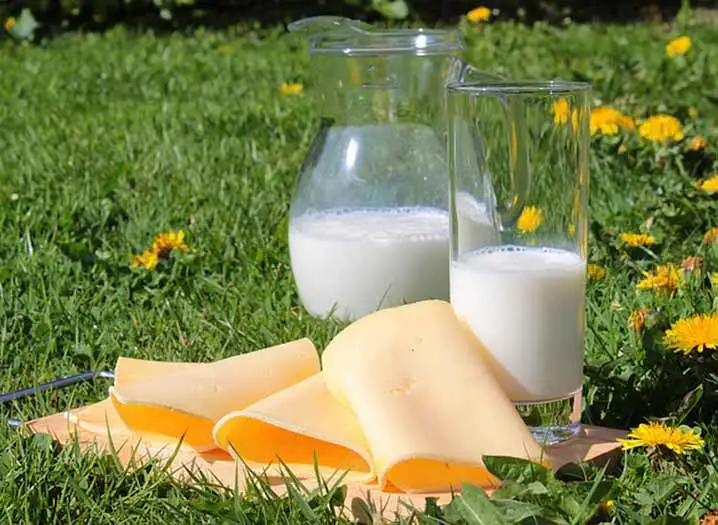Llama milk might sound like a new trend on the milk market, but it has been around for centuries.
Ever since people domesticated llamas in South America, they have been using them for their soft wool, tasty meat, and occasionally for their nutritious milk.
The biggest problem with drinking the milk of a llama is the amount these animals produce. But more on that later.
Llama milk is a white-colored fluid rich in fat and protein, that is produced by female llamas to nourish their young. It has high nutritional quality and consists of around 87% water, 4.1% protein, and 4.2% fat.
In this article, we will look into the benefits, uses, downsides, and taste of llama milk.

Table of Contents
Llama Milk History
Llama milk production is limited to the high mountains of Latin America (Peru, Ecuador, Bolivia, Chile).
During the Inca Empire, llama and alpaca milk were the only sources of dairy for the local populations. However, they refrained from drinking their milk or making cheese from it as much as they could.
According to the Spanish chronicler Padre Blas Valera, Incas refused to milk llamas because the animals “only have sufficient to nourish their lambs”.
Llamas will produce around 67 oz of milk per day (2 L/day). Getting the milk is very hard as llamas have short teats, their udder capacity is limited, so they would need to be milked every 2-3 hours. Llamas give milk for around 8 months.
Nowadays, milk production is very limited to the remote places of the high mountains in South America where there’s no cattle milk available. People there mostly use it for their consumption; they do not sell it.
The llama milk market is still underdeveloped, despite the increasing interest of the Western countries for its nutritional benefits.
SUMMARY
Although it might seem it’s new, people have been consuming llama milk for centuries in the Andean mountains of South America. Despite the increase in demand, it still remains a low developed market.
Llama Milk Nutrition

Llama milk has a high protein and salt content, with lots of calcium and phosphorus. A 100g of llama milk contains about 87 kcal (364 kJ) which is lower than 116 kcal (484 kJ) found in sheep milk.
There is around 4.2g of fat in 100g of llama milk, 4.1g of protein, and 6.3g of carbs (lactose).
It contains more protein than cow and goat milk, around 1g more per 100g.
Here’s how it compares to the milk of other animals.
| Animal | Energy (kcal) | Energy (kJ) | Protein (g) | Carbs (g) | Fat (g) |
| Llama | 87.2 | 364.7 | 4.1 | 6.3 | 4.2 |
| Cow | 76.2 | 319 | 3.4 | 4.8 | 4.1 |
| Goat | 74.5 | 311.6 | 3.3 | 4.5 | 4.1 |
| Sheep | 115.7 | 484.2 | 5.7 | 4.7 | 7 |
| Donkey | 41.8 | 175 | 1.6 | 6.6 | 0.7 |
| Dromedary | 66 | 276 | 3.5 | 4.4 | 3.1 |
| Human | 64.2 | 268.6 | 1.2 | 6.4 | 3.5 |
*per (Fantuz et al, 2016)
Llama milk is fairly similar to cow milk. It has more calories than cow milk, a bit more fat, but a lot more protein (over 0.7g per 100g of milk). Compared to human milk, it has a similar amount of lactose (carbohydrates), but a bit less than donkey milk with 6.6g.
Most of the protein in dairy milk comes from casein and whey.
When it comes to protein in llama milk, most of it is casein. In 100g of llama milk, there’s 3.05g of casein and 0.83g of whey proteins.
| Animal | Protein (g) | Casein (g) | Whey (g) | Non-protein nitrogen (g) |
| Llama | 4.1 | 3.05 | 0.83 | 0.04 |
| Cow | 3.4 | 2.62 | 0.63 | 0.027 |
| Goat | 3.3 | 2.5 | 0.52 | 0.06 |
| Sheep | 5.7 | 4.4 | 1 | 0.1 |
| Donkey | 1.6 | 0.78 | 0.65 | 0.04 |
| Dromedary C. | 3.5 | 2.65 | 0.81 | 0.068 |
| Human | 1.2 | 0.37 | 0.76 | 0.045 |
*per (Fantuz et al, 2016)
Llama milk contains more casein and whey protein than cow and goat milk, but less than sheep milk. The ratio of whey to casein is 1:4 in llamas.
100g of llama milk also contains around 2,950mg of saturated fats.
Here are the essential amino acids found in llama milk and their values.
| Essential amino acids | Amount (mg/100 g of milk) |
| Histidine | 110 |
| Isoleucine | 209 |
| Leucine | 376 |
| Lysine | 315 |
| Methionine | 118 |
| Phenylalanine | 175 |
| Threonine | 167 |
| Tryptophan | n/a |
| Valine | 209 |
* per (Claeys et al, 2014)
SUMMARY
Llama milk is rich in protein and carbs. The protein found in llama milk is mostly casein. It also contains vitamins A, D, C, B5 , B12, omega 3, and linoleic acid.
Llama Milk Benefits
Llama milk is also rich in vitamins. It has significantly more vitamin C compared to cows and goats. It contains more magnesium and phosphorus than cow milk. It has less sodium than cow, goat, or sheep milk.
| Mineral (mg/100g) | Llama | Cow | Goat | Sheep | Donkey | Dromedary | Human |
| Calcium | 195 | 113 | 141 | 200 | 124 | 130 | 30 |
| Iron | 0.07 | 0.03 | 0.07 | 0.09 | 0.15 | 0.2 | 0.12 |
| Magnesium | 15 | 10 | 23 | 20 | 5 | 12 | 3 |
| Phosphorus | 122 | 84 | 116 | 150 | 52 | 82 | 24 |
| Potassium | 120 | 132 | 191 | 128 | 49 | 151 | 58 |
| Sodium | 27 | 43 | 44 | 52 | 18 | 54 | 14 |
* per (Claeys et al, 2014)
Compared to ruminants, llama milk has several distinctive characteristics like the presence of IgG with heavy chains, lack of beta-lactoglobulin, low content of short-chain fatty acids, and high level of unsaturated fatty acids.
Llama milk is rich in immunoglobulins (Igs), an antibody blood protein that protects the immune system against infections. There is about 2,370 mg of it per 100 ml of milk.
Another benefit of llama milk is the lack of β-lactoglobulin, one of the main proteins associated with cow milk allergy.
There is also conjugated linoleic acid (CLA) found in llama milk, around 1%, that might help reduce body fat deposits and improve immune function.
SUMMARY
Llama milk is rich in vitamins and minerals such as calcium, magnesium and phosphorus. It is also low in sodium and potassium – this makes it a good alternative to cow or goat milk. It does not contain beta-lactoglobulin – this makes it a good choice for people with dairy allergies.
Downsides Of Llama Milk
You are safe to drink llama milk. However, you should note that llama milk has a high content of lactose, around 6g per 100g of milk.
In case you are lactose intolerant, you might want to stick to other types of milk.
Another downside is that the milk is hard to acquire because llamas produce so little of it per day.
Low daily production, difficulties in milking, and unconventional animal makes it hard to find and buy llama milk. It can’t be found in local stores – if you want to taste it, you might want to visit some llama farm nearby and ask for a glass of milk.
What Does A Llama Milk Taste Like?
Llama milk has a white color and a pleasant taste. It is medium sweet and not salty.
The colostrum milk, the milk a llama produces in the first days of giving birth, has a pearly yellow color, is salty, and has an unpleasant taste.
Llama Milk Uses

Today, llama milk is mostly used for feeding their babies. Occasionally, owners might milk them for their own consumption and drinking, but that is most probably rare because they give so little milk.
The English naturalist Henry Walter Bates stated that the ancient Peruvians used llama milk as food in the form of cheese. The milk is rich in fats which makes it great for cheesemaking. The cheese is salty, toothsome, and rich in texture.
In one study examining the taste of llama cheese, out of 100 panelists, over 50% rated the cheese favorably, with the most appreciated characteristic being the smell, followed by the texture and the taste.
Humans have not used llama milk to make cosmetics and other products like soaps or creams – at least not commercially.
Llama Milk Facts
- Llama milk is rich in protein and fats. In 100g of milk, there is around 4.1g of protein, 6.3g of carbs, and 4.2g of fat.
- Llama milk contains a lot of minerals, such as calcium, zinc, and magnezium. Compared to cow milk, llama milk has more calcium, iron, and magnesium. It also has less sodium.
- There is a lot of lactose in the milk, arond 6g per 100g of fluid. This makes llama milk a bad option for people with lactose intollerance.
- Llama milk does not contain beta-lactoglobulin, protein that might cause allergic reactions. This makes llama milk a decent substitute to other types of milk, if you are not lactose intollerant, that is.
- The milk of a llama is rich in immunoglobulin – antibody that provides the calf with an immunological protection against surrounding pathogens
- The color of the llama milk is white. If you encounter a fresh llama milk that is yellow, that might be colostrum milk – first milk llama releases after parturition.
- Llama milk has a pleasant and sweet taste. If you try one and it is salty – you probably had colostrum milk.
- Llama milk is rich in fat which makes it a good choice for making cheese. The cheese has a nice taste and a pleasant smell.
- The main issue with milking llamas is getting milk – the animals have small udders, give little milk per day, and do not like being milked.
- Usual milk yield of a llama is around half a gallon per day (2 liters/day).
In case you decide to try the llama milk, make sure to consult with your doctor and dietitian about adding it to your diet. Different studies have shown different values of elements and minerals; that’s why we can’t guarantee the accuracy, completeness, or timeliness of the information here and shall not be liable for any damages or costs in connection with the use of the content contained here.